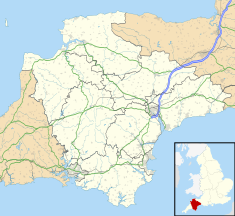| Stevenstone | |
|---|---|
 Image of Stevenstone House published in Morris, Rev. F.O. Picturesque Views of Seats of Noblemen & Gentlemen of Great Britain & Ireland, London, 1880 | |
| Location | St Giles in the Wood |
| Coordinates | 50°57′15″N 4°05′54″W / 50.9542°N 4.0983°W |
| Area | 55,592 acres |
| Demolished |
|
| Rebuilt | 1868-1872 |
| Architect | Charles Barry Jr. |
Listed Building – Grade II | |
This article possibly contains original research. (July 2013) |


Stevenstone is a former manor within the parish of St Giles in the Wood, near Great Torrington, North Devon. It was the chief seat of the Rolle family, one of the most influential and wealthy of Devon families, from c. 1524 until 1907. The Rolle estates as disclosed by the Return of Owners of Land, 1873 (corrected by Bateman, 1883) comprised 55,592 acres producing an annual gross income of £47,170, and formed the largest estate in Devon, followed by the Duke of Bedford's estate centred on Tavistock comprising 22,607 with an annual gross value of nearly £46,000.[3]
From the Glorious Revolution of 1688 to the Reform Act of 1832 the county parliamentary representatives were chosen effectively from only ten great families, mostly territorial magnates. The three most dominant of these were the Bampfyldes of Poltimore House and North Molton, the Courtenays of Powderham Castle, and the Rolles of Stevenstone and Bicton.[4] The Rolles were not from the mediaeval aristocracy as were the Courtenays, but were descended from an able lawyer and administrator of the Tudor era, as were the Russells, later Earls and Dukes of Bedford. Both Russells and Rolles acquired much former monastic land in Devon following the Dissolution of the Monasteries. Indeed, the Rolles were in the opinion of Hoskins (1954) "second only to the Russells in the extent of their monastic and other lands and in time were to surpass them".[5]
In 1669 Sir John Rolle (died 1706), KB of Stevenstone had an annual income of £6,000 making him "one of the richest gentlemen in the country".[6] He died in 1706 seized of more than 40 manors in Devon.[7]
The family built several different houses on the same site known as Stevenstone House, the last Victorian version of which was built between 1868 and 1872. It was significantly reduced in size soon after 1912 and then after 1931 it was gradually demolished piecemeal for building materials.
- ^ Hoskins, p.278
- ^ Hoskins, p.296
- ^ Hoskins, p.88. 3rd was the Earl of Devon with 20,589 acres worth £31,000, 4th was the Fortescue family of Castle Hill with 20,171 acres, worth over £17,000 p/a, 5th was the Duchy of Cornwall with 48,457 acres, much of it moorland, with an annual value of under £5,000
- ^ Hoskins, p.183
- ^ Hoskins, p.84
- ^ Quoted from "Tour of the Grand Duke of Tuscany in 1669", quoted in Hoskins, p.86
- ^ Hoskins, p.87, Quoting Lysons, Magna Britannia, 82,b
